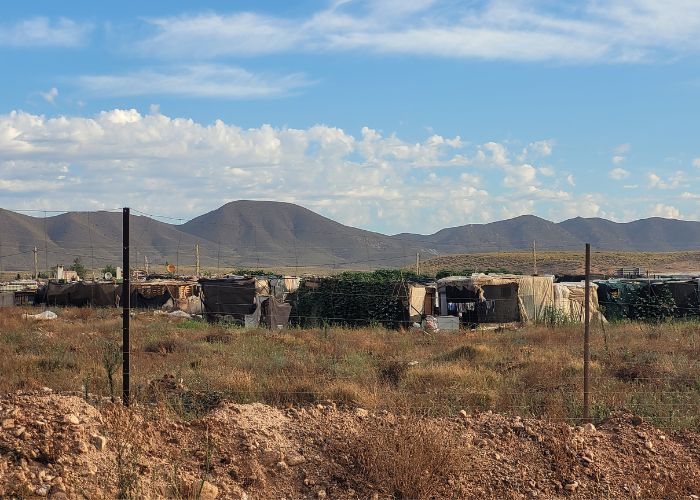NÍJAR – Close to the road that takes tourists from Níjar (Almería) to the beautiful volcanic natural park and coastal area of Cabo de Gata, there is a real slum. Or at least there was, before most of it was demolished this week.
The municipality took the initiative to do this, aided by a court order and a large police force. Excavators demolished the huts built from agricultural waste and trucks took the material away.
As a result of this municipal action, approximately 500 residents are now mostly homeless. The ‘lucky ones’ have moved to similar slums elsewhere in the region. It is estimated around 3,000 people lived in these slum conditions. These are mainly young men from African countries such as Senegal, Algeria, Morocco and Ghana, who work for a pittance in the greenhouses in what is also called the vegetable garden of Europe.
Labour exploitation
The settlements themselves faithfully reflect the stories told within them of the labour exploitation endured by the inhabitants. Employers, associations and administrations agree on the need to eradicate these slums, “provided there is an alternative”.
Lack of housing
Good housing has never been provided, says Juan Miralles, director of Almería Acoge. Hardly any apartments have been built in the region over the last 20 to 30 years. “The only solution is for everyone to agree to build a large public housing stock,” concludes activist Ricardo Pérez, 26, one of many who tried unsuccessfully to stop the demolition of Walili.
Es hora de que el #PSOE y el ayuntamiento de #Níjar asuman su responsabilidad y encuentren una solución digna para los habitantes de #ElWalili. ¡No podemos permitir que se siga marginando a nuestros hermanos migrantes! https://t.co/4LUGNINvWm#Walili #Almería #DesalojoElWalili
— Poder Migrante (@MigrantePoder) February 5, 2023
“No papers, no home”
El País quotes resident Mohamed who posts videos on Tiktok showing how his house in the Walili district is being demolished. “Life is difficult, because no papers, no home,” he tells the newspaper. He has no other option because he works without a contract for €5 per hour in a greenhouse. There was no running water in Walili. Electricity came here and there from provisionally drained pipes. In the slum where he is now going, there is no electricity at all.
High risk for residents
The municipality claims that the dangerous conditions people lived in are the reason for the demolition of the slum. According to Mayor Esperanza Pérez (PSOE), there was a “great risk to people’s lives,” she said at the city council last Friday.
Election measure
The platform ‘Derecho a Techo’ (Right on the roof) criticises the demolition of the houses without offering people an alternative living space. They suspect that it is mainly a measure given the upcoming municipal elections in May. The socialists won the last municipal elections in Níjar; in the general and regional elections, Vox and the PP were the largest.
Alternative housing means loss of work
For the residents who were left without a roof over their heads, a makeshift shed was set up on an industrial estate eight kilometres away. 30 men sleep here. The rest don’t want to, because then they would lose their job. Potential employers aren’t going to drive and spend gas to pick them up, they explain.
Those who want to work gather at intersections and roundabouts early in the morning in the hope that some farm van will pick them up and work all day for a few euros. The men say they will endure everything in the hope of one day being eligible for papers. “Each day we suffer more than the last” is a statement by one of them, who uses El País as the title of the article.
Bad image
Walili was very visible along the road to Cabo de Gata, a protected nature reserve full of beautiful volcanic beaches with clear sea water, where it is good to dive and snorkel. During high season, many tourists pass by. A slum on the way to their holiday destination is bad for the image of the region. Other slums are usually hidden between the many greenhouses. Social groups suspect that this was also one of the arguments for the municipality to tear down Walili.
One of the largest concentrations of greenhouses in the world
Almeria, Spain is home to one of the largest concentrations of greenhouses in the world, spanning over 27,000 hectares. The greenhouses are mainly used for the cultivation of fruit, vegetables and ornamental plants. The companies behind the greenhouses are mainly Spanish, but also multinationals. These companies use advanced technologies such as controlled irrigation systems, plastic films and computerised climate control systems to optimise production and minimise costs.
Furthermore, they also keep costs down by using cheap and illegal labour. Something that the Spanish government officially says it will act against, but in practice nothing has changed. The slums and their inhabitants mentioned above illustrate the downside of the success of Almeria’s greenhouses, which have helped make Spain a major player in the global fresh produce market.
Related post: end of slum in sight for seasonal workers in Spanish strawberry cultivation


